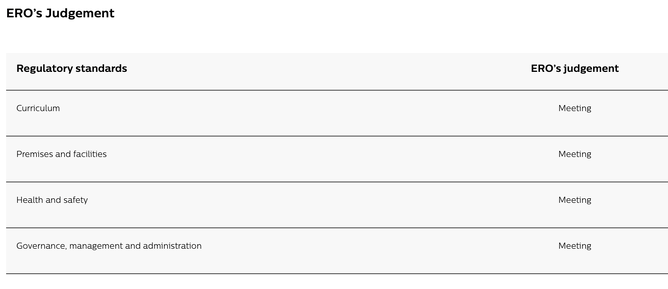Where to start?
We know as parents and whānau a centre's ERO result can be a great place to start to figure out exactly what is happening behind the scenes. We also know it can be really confusing to wrap your head around things, especially when there are changes. We've tried to break this down to the basics, without too much "teacher talk!"
If you want to find out more about ERO, jump on their website and if you want to view our ERO result, you can click here. We'll be discussing it more further down the blog.
Previously...
In late 2020 a new ERO came in. The previous 1 - 4 year review system has now been replaced with Te Ara Poutama.
Previously you would see a simple chart that would then correspond with your time between reviews for example if you were very well placed you were on a four year cycle. The chart looked something like this:
Depending on your result you would be reviewed either annual, or every 2, 3, or 4 years. The ERO team would come in and focus on curriculum and practice within your centre. Now each centre is expected to be reviewed within 3 years.
The Education Review Office ("ERO") has also been resourced up with more ECE qualified team to help stay on track.
Ministry of Education Review - Complianace
Prior to now compliance was completed by the Ministry of Education (MoE). This means that each time a centre was sold and was under new ownership the MoE would come in approximately 3 months later for a compliance check. You can imagine centres could go a long time between these reviews, if their ownership remained the same (unless there were serious concerns/complaints or an incident.)
Te Ara Poutama - Akanuku
This has all changed under Te Ara Poutama. Under new ownership you will still get your MoE compliance check within 3 months of ownership. Then following this, within the first year, the ERO team will come back into your centre to ensure you are continuing with meeting licensing criteria under what is known as an Akanuku review.
Akanuku: an assurance review to assess whether or not a service is meeting regulatory standard.
An Akanuku review involves a print out of the regulations (of which there are many!) and a check box system to show you are meeting the regulations and compliance. The review doesn't go into curriculum and practice but it is expected that the ERO team will return within the year to move into an akarangi review.
A very brief example of the 300+ components of licensing:
Curriculum: i.e. making sure we have language rich environments that weave our bicultural practices and our philosophy throughout of centre. Acknowledging tangata whenua and cultures. Seeing tamariki as learners and supporting their needs.
Premises and facilities: Is our space safe for tamariki? Is is maintained? Do we have appropriate light, heat, ventilation? Are the kitchens safe and appropriate for their needs? Are there tempering valves to monitor the water temperature? Do we have well stocked first aid kits? Appropriate sleep spaces? Enough beds? Waterproof covers on them? Warm blankets?
Health and Safety: Are we following our nappy changing policies? Are we hygienically laundering things? How far apart are our cots/stretchers? How do we manage our hazards? Do we have any animals on site and is there a correct animal management policy in place? What are our first aid qualifications? Have we got good tamaiti (child) protection policies in place?
Governance, Management and Administration: Are our policies correctly displayed and up to date? Do we have an annual plan? An annual budget? How are we reviewing our practice? Are we safety checking our team appropriately? Are we keeping accurate enrolment records?
Just to reiterate the above summary is less than 30 of the actual 300 criteria but the aim of this summary is to give you, as whānau, ideas on what a licensing check consists of.
So what exactly will you see now?
The only thing produced from an Akanuku review is a simple confirmation that the service is either meeting compliance or not.
Where to find the information?
You can search for any service here on the ERO website. Alternatively each centre should have it up for whānau so simply ask if you can't find it.
What does it all mean?
It means that compliance is now being checked at least every 3 years to ensure centres as maintaining their health and safety, policies and procedures etc as part of a MoE initial check or an Akanuku full review.
The final way that the ERO team checks compliance for centres is with every ERO review now starting with a short form Akanuku review. For those centres that have been under the same management or are well established, for example, this involves around 6 regulations that directly influence our tamariki safety, for example sleep, emergency drills and team safety checks. If you fail this 'short form compliance check" portion of your review then you move back into a full Akanuku review.
So is that...it?
Not at all! Next up comes the Akarangi portion of the ERO Review. This is where the ERO team start to dig deeper into curriculum and practice.
Check out our next blog, or part 2 - akarangi!





